With people spending a lot more time at home this past year, the popularity of houseplants soared. I was already well on my journey to becoming a crazy plant lady: After our remodel two years ago, I decided that I would no longer be a plant murderer, and committed to developing a green thumb.
Why? Because they clean the air. (lol JK they actually don’t. More on that below). The real reason is because our new home is uncluttered and cozy-modern and felt a bit stark without plants. They truly make my house feel like a home. Plants may not really do much to purify the air, but they make me so much happier, and that’s an even better reason, in my opinion.
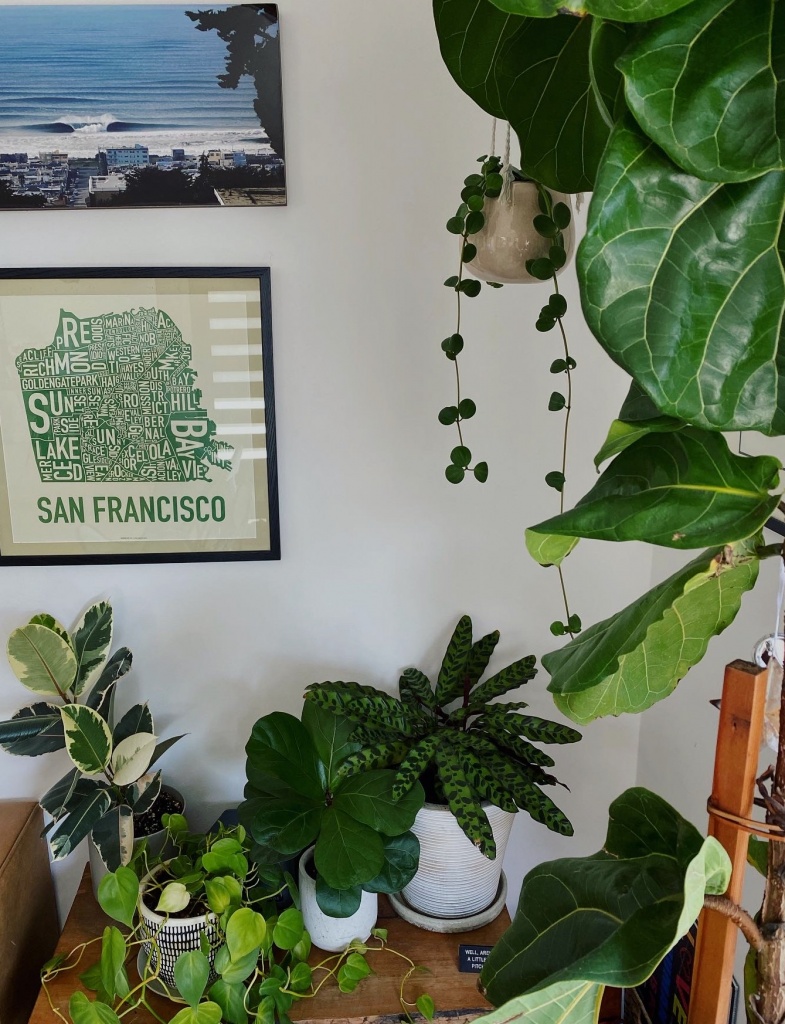
I am now thoroughly obsessed with plants. When we walk by a plant booth at the farmers market, Simon places his hand on my back and gently guides me past it. He knows “looking at plants” is about the same as “looking at a puppy” We have a dog from the last time we went to look at a puppy. And we have around 25 plants. (Our house is not large) He says we’re out of room for more plants, but all I see is more room for plants.
My tips for keeping houseplants alive:
- Choose plants for the light you have. This is the big one- Plants will adjust somewhat to slightly too much or too little water, but if they’re not getting the right light, they will struggle and possibly die.
- Start with easy to care for plants. This depends a bit on your style as well; Lots of people will say that succulents are super easy to care for, but I disagree- they’re the ones I kill the most. I have no force myself not to coddle (Jewish mother) them. And they want a lot of light. The ones outside my house do great.
- Water them – Obviously, right? But you don’t water them too much and you don’t want to forget to water them altogether. The #1 thing for me (since I am very lucky with the light in my home) was to set a reminder on my phone to water the plants on a specific day and time of the week. Depending on the plant, you may not want to water them each week, but you’ll at least be checking the soil and watering them if they need it.
- Feed them – Indoor plants won’t get all the nutrients they need to thrive from the soil they’re in, so it’s good to add some in in the Spring and Summer, when they are in their more active phases. How often and what type depends on a few things, so we’ll talk more about that in a bit.
- Clean them – Dust gathers on leaves of plants, which blocks some of the light from getting through. I use a damp cloth to gently remove any dust when I notice it accumulating (every couple months or so)
How to choose houseplants for the light you have
If you only listen to one thing I saw in this post, listen to this. It’s easy to go into a plant store and leave with the plants you think are the prettiest or the ones that make you happiest. Just remember that they won’t make you quite as happy if it’s a constant battle to keep them alive.
Keep in mind that while there are plants that are supposedly low light tolerant, that doesn’t mean they’re low light loving. They might survive, but won’t necessarily thrive.
When you go to a nursery, take note of where in the shop the plants are. (Assuming the shop has natural light and not grow lights.) If you don’t have a lot of strong indirect light in your home, then the plants in front of a window might not be the best ones for your home. Talk to the people working in the nursery; they know a lot! Check the identification tags in the soil. They will likely give you lots of information like how much water they like, what kind of light they like, and what type of soil they like.
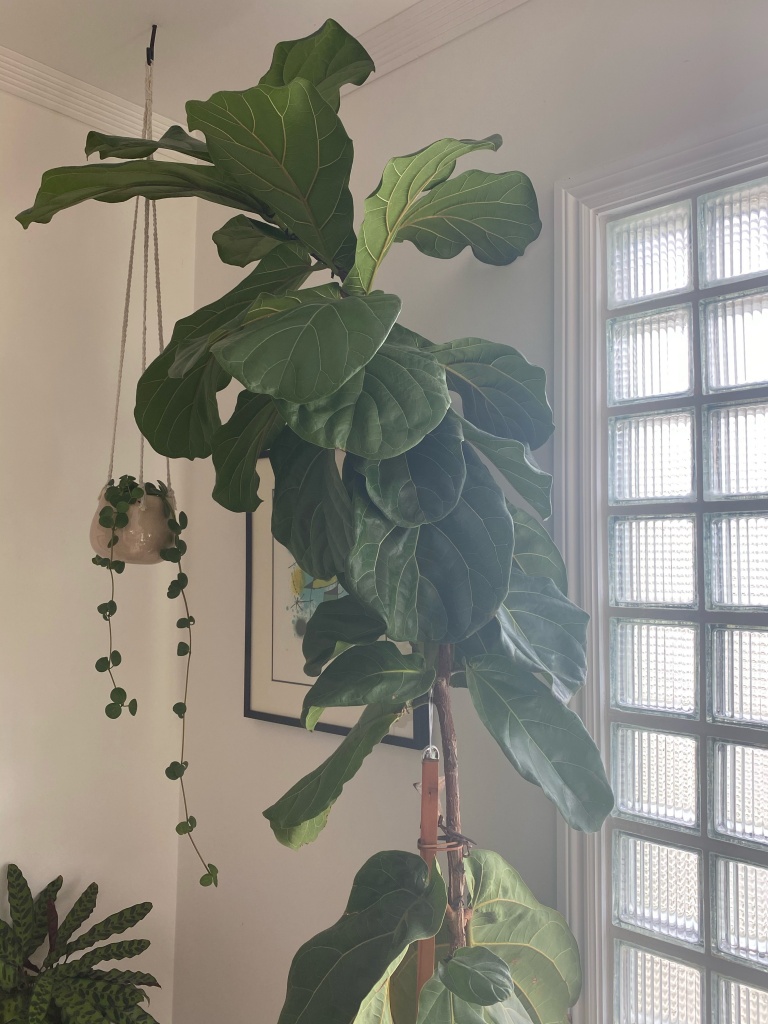
The main part of our home is an open floor plan with a lot of natural light; the majority of the front of our home is East facing and mostly windows. We also have a skylight in the kitchen and one in the space behind the living room. What I’m saying is: I am lucky with the light we have, which means I have lots of options when it comes to plants.
Still, I have to be aware of where in the house I place the plants. The big front window gets too much direct light for some plants. I have a pony tail palm, a Christmas cactus clipping (which may or may not make it), and a pink polka dot plant in that window. The polka dot plant kept flowering and wanting to die, and was pretty close to dead in December. I cut back the old growth that was dead, moved it from the back of the living room to the window, and it has since been thriving.
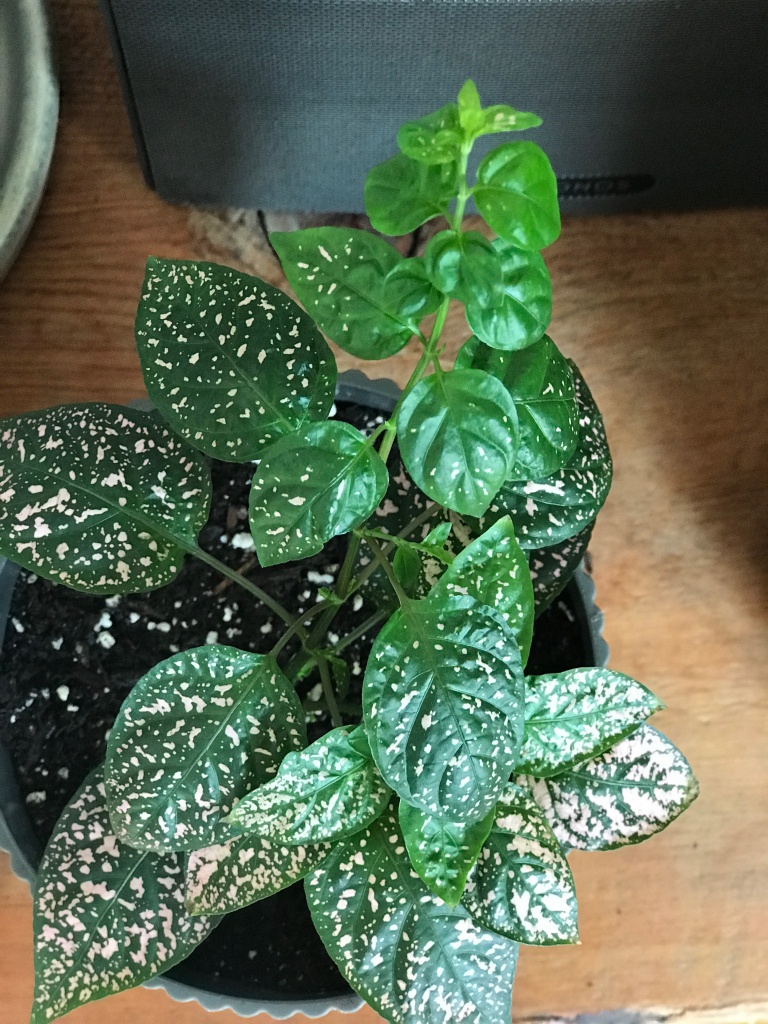
This polka dot plant kept flowering and dying, 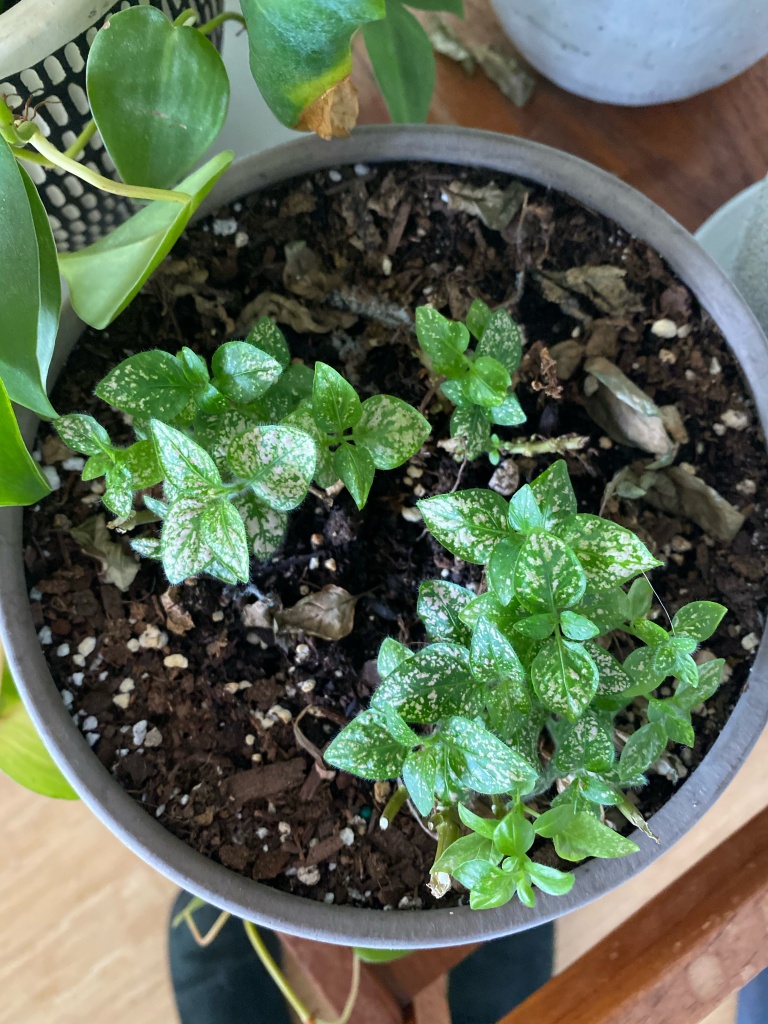
but there was new growth underneath. 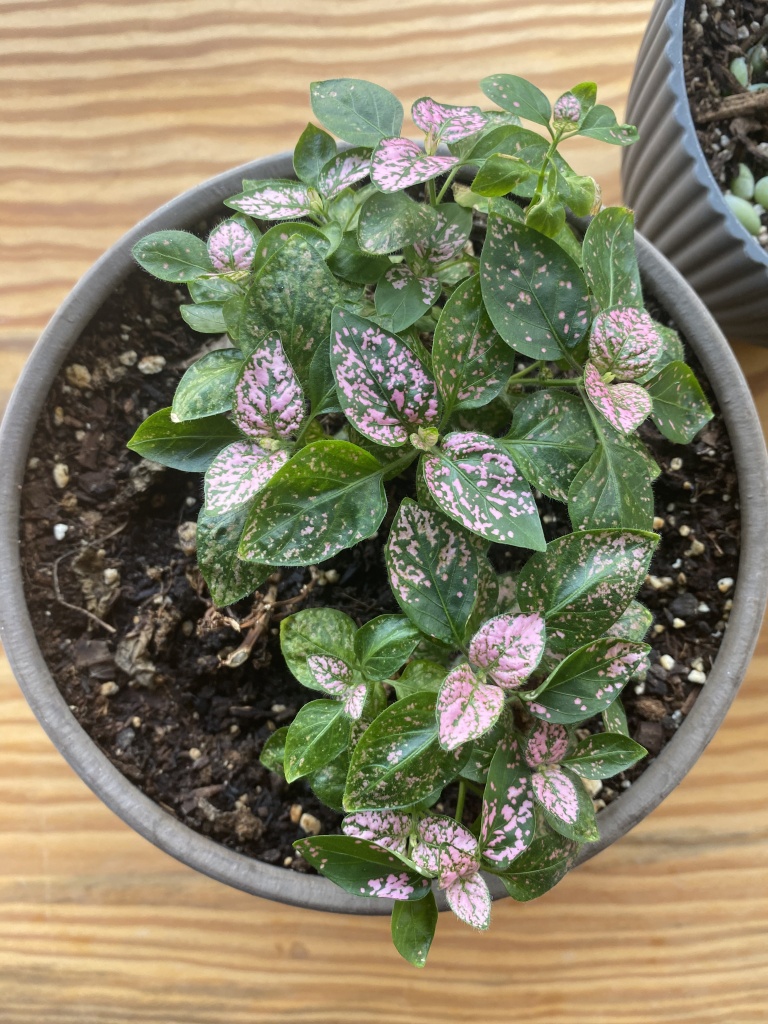
After I cut back all of the old dead growth 
I moved it to the window and it has since been absolutely thriving. (and SO PINK!)
Alternately, my Fiddle Leaf Fig is happy in front of the glass blocks that filter the light, but if it’s too close to the window, the leaves get sun burned.
The easiest to care for houseplants:
Snake plant: If you ask me what plant to get first, it’s this one. It grows fast, does well in moderate light, and doesn’t require a lot of water. They’re also plants that are relatively inexpensive for their size.

Around the time we got this Snake Plant 
About a year later 
Now. (Spring 2021)
I’m 5’7″ for reference
ZZ plant: This is another common houseplant that can thrive in a decent range of light. Once it’s healthy and robust, it’s pretty easy to divide which means… more plants!

Philodendron: This one might be known as the universal starter plant. They are fast growing and extremely easy to propagate.

Rubber Plant: These like bright, indirect light and warm, humid environments. If your house is on the chilly side, this might not be the best one for you, but if you keep it on the warmer side it will do great.
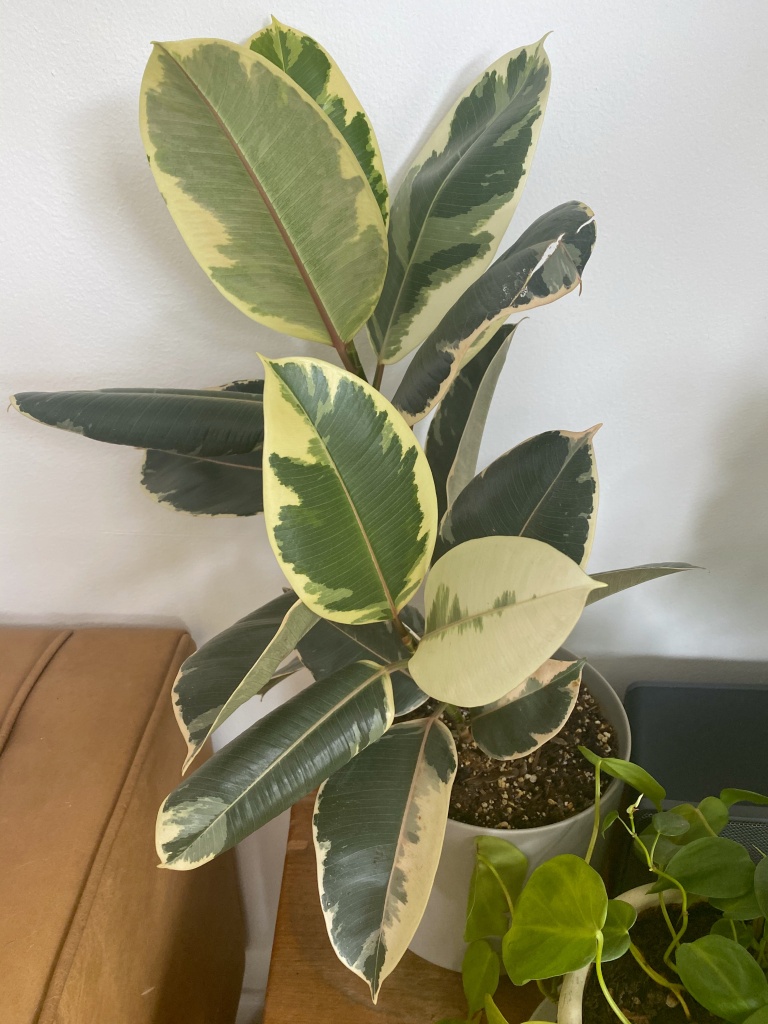
Calathea: This is a good one for low to moderate light. There are lots of varieties of these, so you should be able to find lots of them that you love.
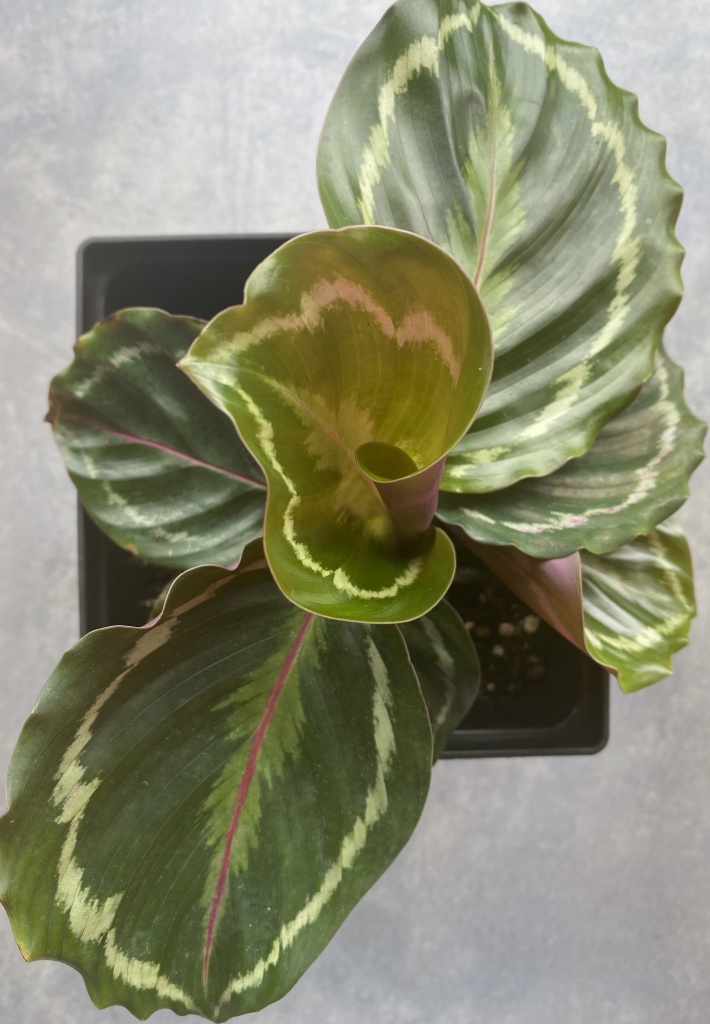
Succulents: Often considered the easiest to care for, but like I mentioned above, that depends on you. I am a succulent murderer, which I blame on my Jewish mother style of plant care. They like bright light and very little water. You’ll notice I don’t have any photos of succulents, because I don’t have any, except for outdoors!
See a plant in a shop and want to know more about it? Download the Picture This app – it lets you take a photo of the plant and it will then tell you just about everything there is to know about it, so you can determine if it’s a good fit for your home and plant parent style.
How often should I water my houseplants?
This of course depends on the plant. Set a reminder on your phone for a day and time each week that you will have time to water them, or at least check if they need water. Doing this was the #1 thing that got me going on my green thumb journey. I couldn’t forget to water them, because my phone literally told me it was time, and the reminder doesn’t go away unless I make it go away. Now, I look forward to watering them and caring for them every weekend, so I don’t even need the reminder anymore.

Most of mine like to be watered once per week, but if the soil is still moist, I leave them alone. Don’t be afraid to stick your finger in the soil! If the top two inches are dry, give her a drink. For plants that like to thoroughly dry out before being watered, skip a week if the soil is still damp.
Again- this is not for succulents, which I will not advise you on, because I murder them consistently. The ones in my outside gardens are thrilled and thriving, because they naturally do well in San Francisco and I don’t coddle them like I do my indoor plants.

Filtered water or tap? A lot of people will tell you to water your plants with filtered water. I won’t tell you not to, but I personally never have. We have decent tap water where we live, and my plants have done really well with it. Some plants may be more sensitive to minerals in water, so filtered water might be best for them.
A lot of people will also tell you to always use pots with drainage holes. I agree with that, but I don’t do it. There are just too many beautiful pots that don’t have them. Going forward, it occurs to me that I can borrow a tool from Simon and drill a hole myself. Another workaround: fill the bottom of the pot with a layer of lava rocks or other stones before adding soil. This will create an area for the excess water to drain so it doesn’t get trapped in the soil and cause root rot.
One more thing about watering: Most of my plants have similar needs when it comes to water, so the once a week schedule works great for us. But! If you have a larger variety and are not sure how to keep track of them, I’d recommend a little covert labeling system: Get a few different types of small stickers and have a key either on paper or on your phone in notes. Small circle stickers that are typically used for a garage sale work great for this. You can place the stickers somewhere inconspicuous but visible to you, and then you won’t have to look up each plant’s needs all the time.
How often should I feed my houseplants?
You don’t need to give your plants much more than water during the Fall and Winter, when they are growing much more slowly. In the Spring and Summer, I like to add some nutrients to their soil every other week, and give them a good feeding every 6 weeks or so.
For nutrients, I took House Plant Journal’s advice and got a Nitrogen – Phosphorus – Potassium (NPK) plant food with a ratio of 3-1-2. I got this one, and add about 1/8 teaspoon per quart of water every other week.
I also bought some extremely stinky plant food that I’m pretty sure is concentrated fermented fish. It’s this stuff, and has the same 3-1-2 NPK ratio as the above, but seems to have more oomph and is good for a once in a while treat. Keep it in the fridge, and open it in the sink.
Simone, why the hell do I need to clean my houseplants?
I won’t go full on 4th grade science class here, but basically the answer is photosynthesis. You know that plants need light, right? They drink up that light through their leaves. If their leaves are covered in a layer of dirt, they’re not getting as much light. Plus, it’s a nice way to love on your plants and tell them how pretty they are and how well they’re growing. Once a month or so, I like to use a soft, damp cloth and just wipe any dust or dirt off of them.

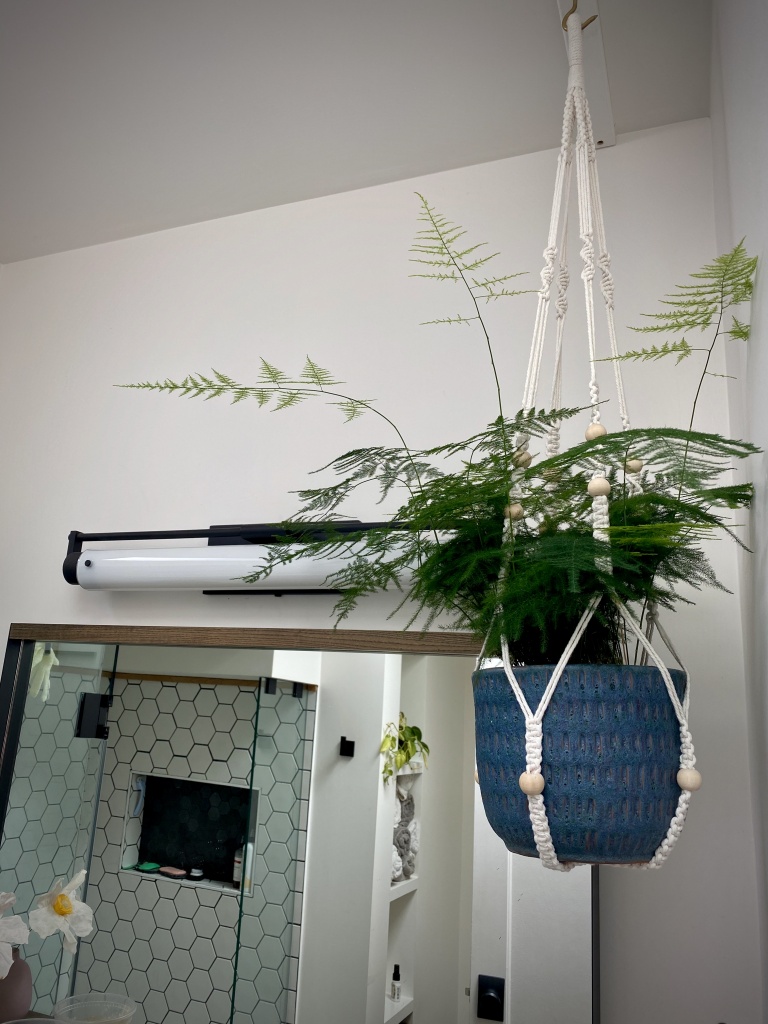
Recommended resources for keeping houseplants alive:
Hilton Carter – my first plant crush. His Instagram feed is beautiful and informative, and his books are fantastic. I also highly recommend taking one of his online plant propagation classes.
House Plant Journal – an engineer’s approach to houseplants. Darryl Cheng is extremely scientific about everything plant related, and has a ton of great info on his site and his Instagram. If you are struggling with how much light each plant needs, he is your guy!
Plant Kween – Just an absolute joy to follow in Instagram. Seriously I can’t not smile when I scroll to one of their posts. Bonus: They’re informative, too!
Got gnats? I am amazed at how well Katchy works to catch them.
I wanted to talk about propagation today, but this post is already long. So I’ll save my experience with that for another day. In the meantime, you’ll learn a lot more from one of Hilton’s Carter’s classes than you ever will from me!
Oh yeah- air purification. A lot of people like to reference the NASA study that was done in the 80’s, but it’s since been thoroughly debunked. Technically, according to the study, plants do purify air, but the study was done in a sealed container with not much air to purify. When you factor in the fact that homes aren’t anywhere near sealed, and the amount of air relative to the amount of plants – even if your home is FILLED with plants – the benefits are so minimal they’re really non existent.
Still! Like I said above, plants are excellent for mental health and if they make you happy, that’s benefit enough.

All of the links on zenbelly.com are for information purposes, however some are affiliate links to books, products or services. Any sponsored posts are clearly labelled as being sponsored content. Some ads on this site are served by ad networks and the advertised products are not necessarily recommended by Zenbelly.

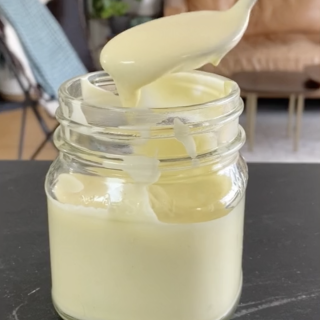


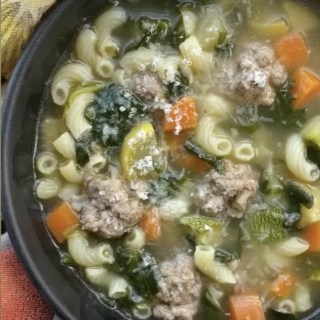
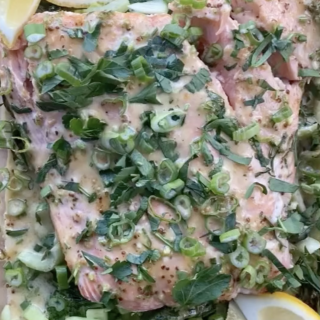
Na says
i had no idea snake plants could grow that height. You are a great nurturer!
zenbelly says
It’s a happy one, that’s for sure! It’s been fun taking care of all these babes 🙂